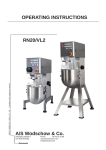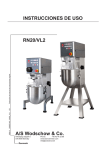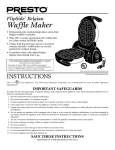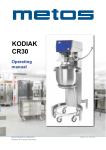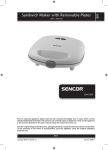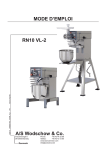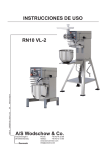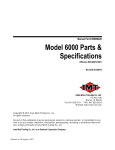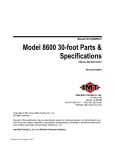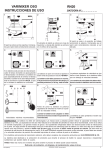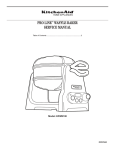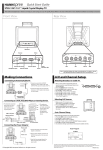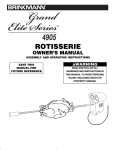Download RN20/VL2 A/S Wodschow & Co. OPERATING INSTRUCTIONS
Transcript
OPERATING INSTRUCTIONS 102006 ORDER NO.: 00011_VL2 GB RN20/VL2 A/S Wodschow & Co. Industrisvinget 6 DK-2605 Brøndby Denmark Phone: +45 43 44 22 88 Telefax: +45 43 43 12 80 www.bearvarimixer.com [email protected] 2 CONTENTS: GENERAL: ......................................................................................................................................................2 ......................................................................................................................................................2 SAFETY: INSTALLATION OF NEW MIXER:................................................................................................................................2 VL2 CONTROL PANEL - SURVEY OF VARIOUS OPERATING SITUATIONS: ...........................................................................3 OPERATION OF THE MIXER: ...................................................................................................................................4 THE REMIX FUNCTION: .........................................................................................................................................5 CHANGE OF FIXED SPEEDS: ..................................................................................................................................5 RESET OF TIMER: ................................................................................................................................................5 OVERLOAD: ......................................................................................................................................................5 PROCEDURE IN CASE OF OVERLOAD: ......................................................................................................................5 RECOMMENDED MAXIMUM SPEEDS: .........................................................................................................................5 CONSTRUCTION OF THE MIXER: ..............................................................................................................................6 THE MAXIMUM CAPACITY OF THE MIXER: ..................................................................................................................6 CORRECT USE OF TOOLS: .....................................................................................................................................7 CLEANING: ......................................................................................................................................................7 MAINTENANCE AND LUBRICATION: ..........................................................................................................................7 ATTACHMENT DRIVE:............................................................................................................................................7 RECOMMENDED MAX. SPEEDS FOR ATTACHMENT DRIVE: .............................................................................................7 DIMENSION SKETCHES:.........................................................................................................................................7 VL-2 CONTROL, ERROR CODES AND POSSIBLE SOLUTIONS: ........................................................................................8 TEST PROGRAMS: ...............................................................................................................................................9 SERVICE INSTRUCTIONS: .....................................................................................................................................10 CABLING DIAGRAM: ...........................................................................................................................................14 ELECTRICAL DIAGRAM:.......................................................................................................................................15 GENERAL: In case of complaints, please contact your supplier. We offer a guarantee period of two years from the date of invoice. The guarantee does not cover faults resulting from faulty operation, overloading and lacking observance of directions of maintenance. It should be checked that all loose parts are delivered with the mixer such as bowl, tools and intermediate pieces. To the attachment drive should only be connected attachments produced by A/S WODSCHOW & CO. If the mixer is placed on a bench stand, it can be placed direct on the floor. Foundation bolts in the floor are recommended. Intermediate pieces can be inserted under the mixer’s feet, if the floor is not completely even. Connection to power: Before the mixer is connected to power, it should be checked that the voltage and frequency printed on the machine label is correct in relation to the place of installation. The machine label is placed at the top right side of the mixer. The mixer must be connected to earth! SAFETY: If not, it will cause missing function of EMC filter as well as risk of damaging the frequency converter. The constant noise level of the workplace of the operator is lower than 70 dB (A). The mixer is designed for manufacture of products which do not during processing cause reactions or emit substances which may be detrimental to the user. Putting your fingers in the bowl while the mixer is running may cause injuries. INSTALLATION OF NEW MIXER: Installation and securing: If the mixer is placed on a table, it must always be bolted into the table top. The bolts fixing the mixer on the pallet can be used for this, no nuts are needed as there are threads in the bottom plate of the mixer (see page 6). • The mixer must only be connected to single phase power with earth. • A two-pin plug with earth is to be used. Alternatively two conductors and earth from a 3-phase power supply. • The mixer must be protected by a differential switch. • The mixer is protected by a 10A fuse. The fuse is built into the frequency converter, which is placed in the bottom of the mixer. 3 VL2 CONTROL PANEL - SURVEY OF VARIOUS OPERATING SITUATIONS: The following pictures show various operating situations and corresponding explanation: 1 Emergency stop is activated - there is no light in the display. If the red diode at is flashing, the mixer has stopped because the safety circuit has been interrupted, either because the bowl arms have been lowered or the safety guard has been opened. 2 The mixer is connected to power and is ready for start - flashing of the green diode at will show that! It is possible to set a start speed by pushing one of the fixed speeds or , before is pushed. When is pushed, the mixer will start in minimum speed. Operating time is stated by pushing or . and thereafter the A program is run by first pushing wanted number, e.g for program No. 1. 3 The mixer is running and a speed has been chosen four diodes on the speed indicator are alight. The speed can be changed by pushing one of the buttons for the four fixed speeds or or . The mixer can be stopped without reset of the timer, by pushing or by opening the safety guard. The mixer is restarted by pushing . 4 has been pushed - yellow diode at is flashing. The mixer is started by pushing . The timer will start again and the speed is running up to the chosen speed. If is pushed, the timer is reset and the mixer will not start, but is ready for start - green diode at will flash (see picture 2). 4 OPERATION OF THE MIXER: Time up Text field (timer) Time down Fixed speeds Pause Speed indicator REMIX-function Speed down Start/Stop Emergency stop Speed up Is activated by pushing red button - is deactivated by turning red button counter clockwise. Before starting the mixer: Mount the required tool in the bayonet shaft. Place the bowl in the bowl arms and raise it to its working position by means of the handle for bowl lift. Close the safety guard. It is possible to change the fixed speeds - see the paragraph „Change of fixed speeds“. The mixer is ready for start. Indication of operation time: Before starting the mixer, an operation time for the mixer can be chosen by pushing or . The operating time will be shown in minutes and seconds in the timer field between and . Start the mixer: Push to start the mixer. Push to increase the speed. Push to reduce the speed. Or push speeds. , , or The maximum operating time is 60 minutes. Inspection of the ingredients during operation: to choose one of the fixed The speed indicator below the fields mixing speed of the tool. to shows the It is now possible to open the safety guard to check the ingredients. Four fixed speeds: For quick choice of speed, use the fields If it is wished to stop the mixer without reducing operation time and speed, push . The mixer will reduce speed and then stop, the operation time will also stop. to . Field corresponds lowest speed, aprox. 98 RPM. Field corresponds aprox. 172 RPM. Field corresponds aprox. 267 RPM. Field corresponds maximum speed, aprox. 365 RPM. Close the safety guard and push , and the mixer will start and will increase the speed to the speed chosen before pushing . The operating time will also be continued. If the bowl is lowered while the mixer is stopped, the operating time is reset, and must be pushed to restart the mixer. 5 THE REMIX FUNCTION: RESET OF TIMER: The special Remix-function is a shortcut to programming of recipes. While the mixer is operated, all commands are stored, is pushed, it is possible and when a recipe is finished and to store the entire recipe under a program number. The timer can be reset by simultaneously pushing and . If the timer is reset while the mixer is running, the mixer will stop. • There are four program numbers. • A program cannot be deleted, but can be replaced. • The programs are not deleted in case of no power. OVERLOAD: Do not overload the mixer. Sticky and heavy doughs may reduce the capacity of the bowl by 75%. The capacity is further reduced if the speed of the mixing tool is increased beyond the recommended values or if a wrong mixing tool is used. Large lumps of fat or cooled ingredients must be cut into small parts before they are placed in the bowl. How to store a program: • First push . • Run the entire recipe including pauses and changes of speed. • Push • Store the program as program No. 1 by pushing both and continuously, until the total length of the program is shown in the timer field. The timer field will thereafter flash „P1“ three times. PROCEDURE IN CASE OF OVERLOAD: . How to run a program: • First a short push on and then on . Now „P1“ appears in the timer field and immediately thereafter the total length of the program will be shown. The program is run by pushing . • If the speed or the time is changed, or is pushed when running a program, the program will be left and the mixer must be run manually. • It is possible to open the safety guard while running a program. When the safety guard is closed, the program can be resumed by pushing . • If the program is containing a pause, the mixer will stop and at the same time an acoustic signal is heard. When and the operator wants to restart the mixer, push the program will be resumed. CHANGE OF FIXED SPEEDS: For the fields and it is possible to change the speed for future mixing jobs. Push or to adjust the speed up or down. If required to store the adjusted speed, push or until two beeps are heard and the diodes of the speed indicator are flashing. The adjusted speed has now been stored in the memory. To return to the factory settings for button and and simultaneously, until a beep is heard. Overload over a long period will cause that the thermal overload relay will switch off the mixer. Follow the description under „Procedure in case of overload“ push • Push emergency stop • Release emergency stop. • Start the mixer by pushing . RECOMMENDED MAXIMUM SPEEDS: Recommended maximum speeds (factory setting). 6 CONSTRUCTION OF THE MIXER: Attachment drive Emergency stop Machine label Arrow indicating the rotation direction of the planetary head Toothed belt Planetary head Motor Bayonet socket Bowl lift Bottom plate Bowl lift arms Screws for fixing on table Nut retaining the bottom plate THE MAXIMUM CAPACITY OF THE MIXER: RN20/VL2 Dough with AR = 60% 10 kgs a given AR AR = 50% 6 kgs (%AR) AR = 40% 4,5 kgs AR = Absorption Ratio (%AR) (Liquid in % of solids) Example: A basic recipe contains 1 kg of solids and 0,4 kg of liquid: This gives AR = 0,4 kgs x 100 = 40% 1 kgs RN20/VL2 Egg white 1L = 30 eggs 2L Whipped cream 9L Other Mayonnaise (L oil) 9L products Mashed potatoes 10 kgs Biscuit bottom 8 - 10 Dough (50 %) 6 kgs Sponge cake 12 kgs If for instance it is required to use the maximum capacity of the mixer, the calculated AR = 40% is used for determining the amount of solids and liquid in the dough: If a 20 L mixer is used, and a dough with AR = 40% is to be kneaded, the maximum capacity is = 4,5 kgs. Now the weight of solids in this dough is calculated: Solids = Max. capacity x100 = 4,5 kgs x 100 = 3,2 kgs AR + 100 40 + 100 Weight of liquid = 4,5 kgs - 3,2 kgs = 1,3 kgs 7 CORRECT USE OF TOOLS: RECOMMENDED MAX. SPEEDS FOR ATTACHMENT DRIVE: Recommended applications for tools: Whip Beater Hook Cream Cake dough Bread dough Egg whites Butter cream Dark bread Mayonnaise Waffle dough and the like and the like Minced meat and the like Whips should not be struck against hard objects as e.g. the edge of the bowl. This will make the life of the tool shorter due to increasing deformity. For production of mashed potatoes the special wing whip should be used, not the standard whip. CLEANING: The mixer should be cleaned daily or after use. The mixer should be cleaned with a soft cloth and clean water. Sulphonated soaps should be used with caution as they destroy the mixer’s lubricants. Recommended max. speeds for attachment drive (factory setting). DIMENSION SKETCHES: Never use high pressure cleaning for the mixer. Bowls and tools of aluminium must not be washed with strong alkaline detergents (pH not bigger than 9.0). The soap suppliers can recommend the correct type of soap. MAINTENANCE AND LUBRICATION: When the mixer is delivered, it has been greased for life and will need no further lubrication. If the planetary head is repaired, the toothed wheel and the toothed wheel rim shall be greased with Castrol Molub Alloy 936SF Heavy or Castrol Grippa 355, the needle bearings of the planetary head must not be greased with this type of grease. Dimension sketch for RN20 on floor stand. If the mixer is provided with attachment drive, the gear for attachment drive must be greased with ESSO Fibrax EP 370. Do not use any another type of grease than the one stated here. ATTACHMENT DRIVE: The mixer can be equipped with attachment drive for mounting of extra accessories, such as meat mincer or vegetable cutter. For further information regarding mounting and use of extra accessories, please see the manual following the accessory. The mixer must be disconnected while the accessory is mounted in the attachment drive! Dimension sketch for RN20 table model. 8 VL-2 CONTROL, ERROR CODES AND POSSIBLE SOLUTIONS: Error codes and possible solutions: The VL2 control will in case of certain errors show an error code in the display: Too high temperature in the frequency converter. Solution: Switch off the mixer and let it cool down. Wrong voltage of power supply. Solution: Compare the voltage indicated on the machine label with the power supply. The motor has been constantly overloaded for a long period of time. The load has been between 100 - 150% of maximum load. The overload is typically found in case of mixing/whipping tasks with constant load. Solution: Switch off the mixer and reduce the quantity of ingredients in the bowl. Use lower speed on start up again. The motor has been overloaded for a short period of time, the load has exceeded 150% of maximum load. The overload is typically found in case of kneading tasks with variable load. Solution: Switch off the mixer and reduce the quantity of ingredients in the bowl. Activate the emergency stop and release it again. Use lower speed on start up again. If the error code has not disappeared, the frequency converter is defective. See “Service instructions” page 10 for access to the frequency converter. Too high temperature in motor. Solution: Switch off the mixer and let it cool down. Reduce the quantity of ingredients in the bowl. Use lower speed on start up again. Errors that do not cause an error code in the display: The mixer does not start when is pushed, but the timer is counting as normal. There is no error code in the display. Solution: The frequency converter is defective and must be exchanged. See “Service Instructions” page 10 for access to the frequency converter. The mixer does not start when is pushed. There is no error code in the display. Solution: Activate emergency stop and release it again. Now two different codes should be shown in the display. The first code is a small square in top of the first cipher of the display followed by a version code, this is the software version of the control panel. The next code is a small square in bottom of the first cipher of the display followed by a version code, this is the software version of the frequency converter. If no codes are shown or if only the first code is shown, the error can derive from either a defective communication cable between the control panel and the frequency converter, or a defective frequency converter. The mixer is totally “dead”, no light in the control panel. Solution: Check the connection to power supply, if connection and power supply are OK, the error is either a defective communication cable between the control panel and the frequency converter, or a defective fuse in the frequency converter. See “Service Instructions” page 10 for access to the frequency converter. 9 TEST PROGRAMS: To enter the test mode of the mixer, do as follows: Raise the bowl and close the safety guard, push emergency stop. Hold and and release the emergency stop at the same time. Now go through four test programs: Test program 1: Test of fields. OBS. The fields must be activated in the following order: Briefly push the following fields – – – – – – – – – – . The mixer will now automatically run the next three test programs. Test program 2: Test of light diodes. For the first 20 seconds the cipher 2 will flash in the display - the remix memory will be erased. Then the light diodes in the speed indicator will light up one by one, while the other light diodes of the control panel are on. Test program 3: Test of current measurement circuit in the frequency converter. The motor starts and runs for approx. 20 seconds. After the 20 seconds a text is shown in the display, this text will vary and can only be used for testing the function. Test program 4: Test of micro switches in safety circuit. OBS. It is important that the order is kept. The cipher 1 is shown in the display until the safety guard is opened. • Open and close the safety guard. The display shall now change to 2. If the display does not change to 2, the micro switch at the safety guard is defective. • Raise and lower the bowl again. The display shall now show 3. If the display does not change to 3, the micro switch at the bowl lift is defective. • Conclude the test by pushing emergency stop and release it again. The display shall now show version codes for control panel and frequency converter resp., as earlier mentioned under “VL2 control, error codes and possible solutions, error . 10 SERVICE INSTRUCTIONS: Before a possible repair or adjustment, the power must be switched off by dismantling the connection cable from the power supply. 9 16 1 15 12 11 18 Cable bundle stuck to motor base with strips. 14 13 10 4 3 5 6 2 7 8 Cable bundle 17 19 20 20 22 27 20 21 23 11 1 The lid of the mixer shall be removed and the plastic cover (2) shall be loosened by removing the 2 screws (3). 4 The control panel is removed by first removing the plastic ring (7) and the finger screw on the attachment drive, and then loosening the 2 screws (5). 6 The attachment drive is taken out by removing the finger screw and removing the plastic ring (7), the control panel (4) and the 4 bolts (8). 9 The display print is removed by removing the 2 screws (10). 11 The toothed belt is exchanged in the following way: a) Remove the lid of the mixer (1) and the plastic cover (2). b) Loosen the four nuts (12) holding the motor base (13). By pushing the base towards the front of the mixer, the belt is slackened and can be lifted off the motor pulley (14) and the planetary head pulley (15). c) The new toothed belt is mounted by pushing it downwards over the two pulleys. d) The toothed belt is tightened by pushing the motor base towards the back of the mixer. Use a big screwdriver or the like to hold the base in its place, while the nuts are mounted and tightened. 14 + 15 The pulleys are taken off in the following way: a) Remove the lid of the mixer (1), the plastic cover (2) and the toothed belt (11). b) Screw the pointed screws (16) out of the pulley. The pulley can now be lifted off the locking ring. c) The locking rings are loosened from the shafts by screwing one of the pointed screws approx. one turn down in the middle centre hole. The locking ring can be removed. 17 16 15 The motor can be taken out in the following way: a) The power must be switched off, or the connecting cable dismantled from the power supply. b) Take off the lid of the mixer (1), the plastic cover (2), the toothed belt (11) and the motor pulley (14). d) Remove the four nuts (12) and cut the strip holding the cable bundle on the back of the motor base. The motor base (13) with motor (17) can now be lifted out above the mixer. e) Motor base and motor can be separated by removing the four screws (18). 19 The legs of the mixer are taken off by removing the screws (20). 21 The frequency converter is taken out in the following way: 26 a) Remove the lid of the mixer (1). b) Cut the strips holding the cable bundle to the motor base (13). c) Remove the screw (22) in the bottom of the mixer. d) The frequency converter including the mounting plate (23) can now be tilted/lifted out of the bottom of the mixer. e) Dismantle all plugs for the frequency converter. f) The cover box (24) above the frequency converter (21) can be removed by loosening the screws (25). 26 The fuse is exchanged by taking out the frequency converter including mounting plate (23) and then removing the cover box (24). 27 The bottom plate is taken off by removing the legs of the mixer (19), and the 2 nuts (28). 24 25 22 27 23 21 12 30 1 11 4 6 31 35 33 32 34 29 29 The planetary head is taken off in the following way: a) Take off the lid of the mixer (1), control panel (4), attachment drive (6), and toothed belt (11). b) Take out the screws (30) c) The plastic ring (31) can be taken off by hitting it slightly against the front edge and thereafter pressing a screwdriver in between the plastic ring and the metal plate at the top of the plastic ring. d) Take off the rubber packing (32). e) The stainless steel head cap (33) can now be taken off by hitting the front edge slightly with a plastic hammer, turning the planetary head 1800, and hitting again slightly on the front edge. f) If only the bottom part of the planetary head is to be repaired, follow the instructions from c) to e). Hereafter the planetary head can be disassembled by taking out the 3 bolts (34). g) By loosening and removing the 4 bolts (35) the planetary head can be lowered. Mounting of the planetary head to be in reverse order. 13 35 Micro switch for bowl lift can be exchanged in the following way: a) Take off the lid of the mixer (1) and the plastic cover (2). b) Remove the base for motor (13) with the motor (17). c) Access is now free to the bowl lift micro (35), which can be exchanged by removing the two wires and loosening the screws (36). d) The new micro switch is mounted by following the instructions in reverse order. No adjustment is needed. 35 36 39 Micro switch for safety guard can be exchanged in the following way: a) Remove the lid of the mixer (1) and the operating panel (7). b) Screw out the pointed screw (37), and the cam disc (38) can be removed. c) The fitting with micro switch (39) can now be removed, and the micro can be exchanged by removing the screws (40). It might be necessary to loosen the screws (41) before the fitting can be taken out. d) The new micro switch is to be screwed on to the fitting, and the fitting to be placed in the machine. It is important that the two screws (41) are adjusted so that the fitting is horizontal. 41 37 38 39 40 14 CABLING DIAGRAM: Red Blue White Yellow Green 6 5 4 3 2 1 6 5 4 3 2 1 Red Blue White Yellow Green Black 6 5 4 3 2 1 6 5 4 3 2 1 Safety guard Red Blue White Yellow Green Black 1 - Red 2 - Blue 3 - White 4 - Yellow 5 - Green 6 - Black 6 - Brown (T2) 5 - Red (bowl) 4 - Black (Safety guard) 3 - Blue (T1) 2 - Red (bowl) 1 - Orange (Safety guard) 4 - Black 3 - Blue 2 - Blue 1 - Black 1 - Brown (L) 2 - Blue (N) 4 4 3 3 2 2 1 1 6 Yellow/Green Brown Blue Black Emergency stop 3 - Yellow/Green (PE) 1 - Yellow/Green, (PE) 2 - Brown (M3) 3 - Blue (M2) 4 - Black (M1) 6 CE/Bowl 3 3 5 5 2 2 4 4 1 1 Orange Orange Black frequency converter Red Red Black Black Red Red Blue Blue Brown Brown Blue Blue Orange Orange Brown Brown Black Black Control panel 2 3 3 1 1 1 2 2 2 3 3 1 4 4 Yellow/Green Brown Blue Black 4 1 2 1 2 1 2 3 4 1 2 3 Brown Brown Yellow/Green White Red Black T=145o Motor 15 ELECTRICAL DIAGRAMMES: OBS: The mixer is to be connected to power via a plug. The plug must be dimensioned for min. 16 A, 230/400V~, IP44 When connecting; 1 phase with 0 + earth, use 3 pole plug 2 phases + earth, use 3 pole plug 3 phases + earth, use 4 pole plug 3 phases with 0 + earth, use 5 pole plug 16
















